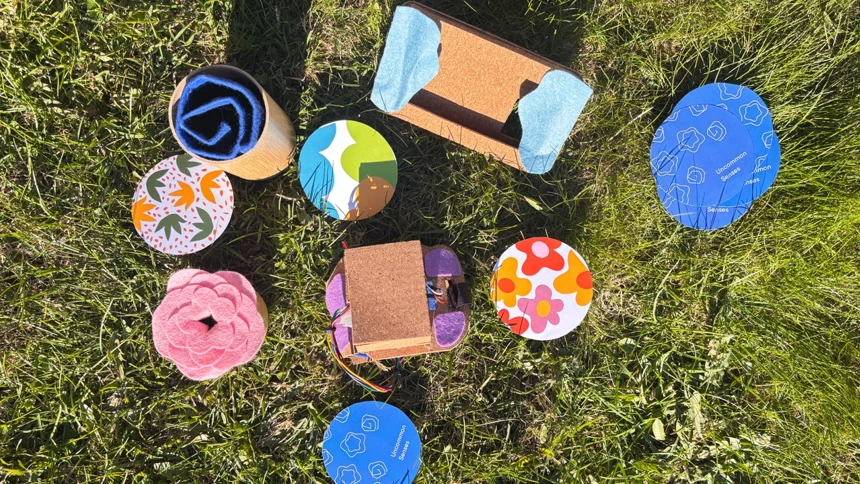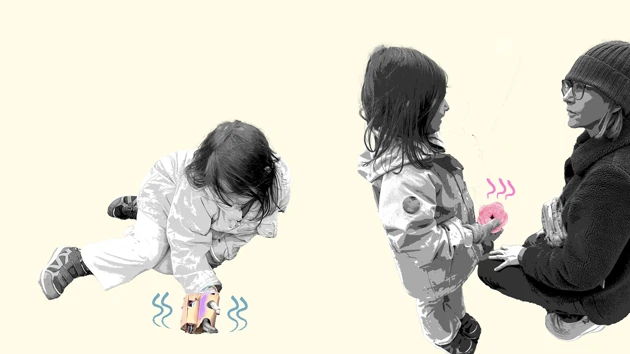Use case scenarios with children testing out the early prototypes.
Sensing differently: A child-centred vision of design and nature
In a quiet park in northern Sweden, a group of children gather around a small, curious object nestled in the grass. It hums faintly, then releases a soft vibration. One child leans in, another giggles, and a third crouches down, whispering to a patch of moss as if it might whisper back. This is not a science experiment or a toy demonstration. It is a moment of shared curiosity, and it is exactly what Anjuli Acharya hoped for.

Uncommon Senses explores how interaction design can shift the way children relate to their environments by designing with perception as material.
Anjuli, a graduating student from the MFA Interaction Design programme at Umeå Institute of Design, grew up in India surrounded by nature. “I remember I had this squirrel who used to live in my backyard,” she says. “I was really curious about where it went, what it did. That kind of wondering stayed with me.” Her thesis project, Uncommon Senses, is a tribute to that early sense of wonder, and a challenge to how we think about learning, technology, and our relationship with the natural world.
A different kind of learning
Children are often taught about nature through facts, diagrams, and structured activities. But Anjuli wanted to ask a different question: what if we didn’t teach children about nature at all? What if we simply invited them to sense it differently?
Uncommon Senses is a set of five interactive artifacts designed for outdoor play. Each object responds to environmental cues like moisture, vibration, light, or stillness, offering subtle feedback through sound, scent, or touch. The goal is not to explain, but to provoke. “Design is often centred around human needs,” Anjuli explains. “But what if we expanded that circle to include more-than-human relationships?”
Hear Anjuli Acharya talk about her grad project 'Uncommon Senses'. Her work explores how sensor-based playthings can help children reconnect with nature and other species through multisensory interaction.
The project encourages children to slow down, to notice, and to co-sense with their surroundings. It is not about simulating how animals perceive the world, but about opening up space for children to imagine, interpret, and relate in new ways.
From screens to soil
In an age of screen-based learning and digital distraction, Uncommon Senses offers a refreshingly tactile alternative. The artifacts are deliberately low-tech and ambiguous. They do not flash or beep or instruct. Instead, they invite. A soft vibration might signal the presence of moisture in the soil. A filtered sound might shift depending on how still the child becomes. These subtle cues encourage embodied exploration and relational play.
Anjuli’s design process was rooted in fieldwork and play sessions with children aged five to seven. She observed how they interacted with early prototypes in parks, homes, and schools. “I wasn’t trying to solve a problem,” she says. “I was trying to see what happened when we disrupted their usual ways of sensing.”
What she found was that children didn’t need much prompting. They invented stories, assigned personalities to the objects, and began to ask questions, not just about the tools, but about the world around them.
Designing for the more-than-human
The philosophical underpinning of Uncommon Senses is as radical as it is gentle. It challenges the dominant logic of design as something that instructs, rewards, and resolves. Instead, it proposes design as a scaffold for co-sensing, for being-with, and for embracing uncertainty.

Anjuli refers to her artifacts not as teaching tools, but as “relational prompts.” They are meant to be interpreted through the child’s own logic, body, and imagination. In doing so, they foster a kind of attention that is less about understanding and more about presence.
A future rooted in curiosity
As climate anxiety grows and children become increasingly disconnected from the natural world, Uncommon Senses offers a hopeful alternative. It does not preach or prescribe. It simply invites children to notice, to care, and to wonder.
For Anjuli Acharya, this is not just a design project. It is a quiet act of resistance against a world that too often prioritises efficiency over empathy, and explanation over experience. “I want children to start thinking about the existence of these other beings,” she says. “And how their needs might be different. How can we start thinking about these beings even when we are designing as designers?”
In a world that often asks children to sit still and listen, Uncommon Senses asks them to move, to feel, and to imagine. And in doing so, it reminds us that sometimes, the most powerful kind of learning begins not with knowing, but with sensing.
